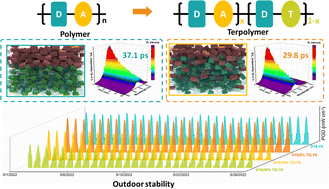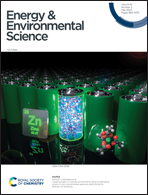Rationale for highly efficient and outdoor-stable terpolymer solar cells†
Abstract
Random terpolymerization is an effective approach to achieving highly efficient and outdoor-stable terpolymer photovoltaics. However, the working principle behind this remains unclear. Herein, we report spectroscopic, morphological, and computational results and conclude the previous work on terpolymer research to unveil their structure–property relations and elucidate key rules for high-efficiency and outdoor-stable terpolymer photovoltaics. More specifically, introducing a strong electron-deficient or electron-rich third moiety is suggested to enable broadened absorption with minimized non-radiative voltage losses. Besides, the third component should manipulate the D/A miscibility towards a thermodynamically more stable morphology. However, the content of the third component should be small to maintain molecular orientation and exciton diffusion length in conjunction with optimized phase-separation and crystallinity, in turn reducing bimolecular carrier recombination. Obeying these rules, terpolymer solar cells based on the parent donors D18 and PM6 with enhanced power conversion efficiency (PCE) and excellent outdoor stability are demonstrated. Our findings provide a rationale for explaining and achieving high-performance and outdoor-stable terpolymer photovoltaics, paving the path to commercialization.

- This article is part of the themed collection: Recent Open Access Articles


 Please wait while we load your content...
Please wait while we load your content...